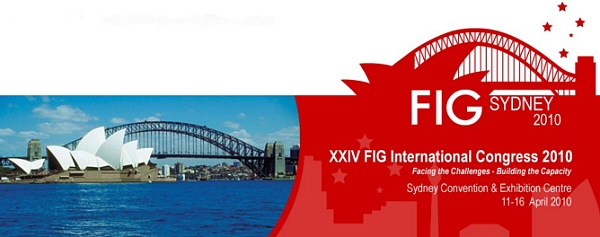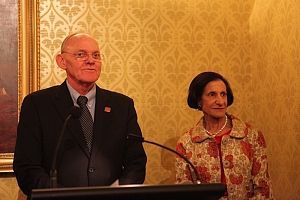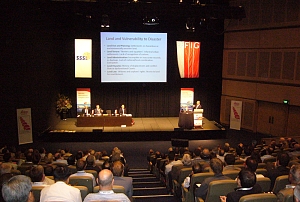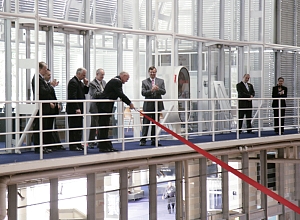|

XXIV FIG Congress – Facing the Challenges – Building the
Capacity
Biggest FIG Congress in the history full of professional
highlights
The XXIV FIG Congress Facing the Challenges – Building the Capacity
held in Sydney Australia 11-16 April 2010 turned out to be the biggest FIG
congress ever. With more than 2,200 participants from 100 countries it
gathered the biggest attendance to an FIG event. Among participants there
were 120 students and 250 accompanying persons.
The technical programme with more than 1,000 offered papers out of
which more than 700 were presented in Sydney was a big hit. In totally there
were more than 150 technical and flash sessions, workshops and special
seminars. The total number of presented papers exceeded 800. The
participants packed both plenary halls and technical session rooms at the
Sydney Convention and Exhibition Centre in Darling Harbour in the heart of
Sydney.
|

Aboriginal welcome at the Opening Ceremony.
|

President Stig Enemark and Governor Dr. Marie Bashir
at the reception in Government House. |
Opening ceremony
The opening ceremony at the SCEC gathered almost 2,000 people to listen
to the opening speeches and the aboriginal welcome to the country presented
by representatives of the Cadigal tribe. Their presented included the “songlines”
that connect people and land and mark routes.
The welcome addresses were made by Mr. Jonathan Saxon who
represented SSSI on behalf of President Michael Giudici who was not
able to attend the congress because of health problems. Other welcome
greetings were presented by Mr. Tony Kelly, Minister of Lands and
Congress Director Paul Harcombe.
FIG President Stig Enemark stated in his opening address that “the
key challenges of the new millennium are climate change; food shortage;
energy scarcity; urban growth; environmental degradation; and natural
disasters”. All these issues relate to governance and management of
land. This means that it relates directly to each surveyor and the national
surveying associations. President Enemark continued that “Sustainable
land administration systems provide clear identification of the individual
land parcels and land rights attached to these parcels. This information on
the people to land relationship is crucial and plays a key role in
adaptation to climate change and in prevention and management of natural
disasters.” He further emphasized that "the land management
perspective and the operational component of integrated and spatially
enabled land administration systems need high-level political support and
recognition. The surveyors – the land professionals – are in a very core
position.”
The official opening from the Australian hosts was made by Hon. Dr.
Marie Bashir, Governor of New South Wales, Australia. In her opening
remarks she stated “I have been increasingly interested in and
appreciative of the contribution of surveyors — the modest and often unsung
heroes of civilization”. Dr. Bashir also unveiled the statue of James
Meehan, one of the surveyor pioneers. The full size statue was shown at
the exhibition during the congress.
The opening keynote address was given by Dr. Tim Flannery, one of
Australia’s leading thinkers and writers. He is an internationally acclaimed
scientist, explorer and conservationist, Australian of the year 2007 and
chair of the Copenhagen Climate Council (a think tank on the climate
change). He stated in his speech that “surveyors are the custodians of an
enabling technology that is critically important to our future. Surveyors
should take a leading role, not only in monitoring climate change, but in
explaining it to the broader public. You operate well in harsh conditions”.
He also discussed the special conditions in Australia that will be first
affected by the climate change because of its vulnerable nature and hard
environmental conditions as well as its highly populated coastal areas.
Plenary sessions
At the congress there were four plenary sessions. In the first session
that focused on the FIG achievements 2007-2010 President Enemark summarized
the most important activities that have been taken during the last four
years. This was a most impressive list covering not only the FIG events and
joint events with partners like the World Bank, FAO and UN-HABITAT, but it
included also several projects and achievements where some of them are
described in more detail in the eight new FIG publications that were
launched in Sydney.

Plenary session on spatially enabled societies: Warwick Watkins,
Santiago Borrero and Abbas Rajabifard. |

Plenary sessions gathers full halls - here session on the big future
challenges. |
The second plenary session focused on spatially enabled society. Dr.
Abbas Rajabifard, President of GSDI, identified in his keynote
presentation that “spatially enabled society is a scenario where a
society manages their information spatially by using a spatial component.
This requires data and services to be accessible and accurate,
well-maintained and sufficiently reliable for use by the majority of society
which are not spatially aware.” He further talked about a transition
from Spatial Information Management to Managing Information Spatially.
In support of this Mr. Santiago Borrero, President of PAIGH,
talked about the need for strong links between politics and the numerous
disciplines of the surveying profession to enable better land governance. He
also challenged FIG to play a leading role in relation to this. Finally,
Surveyor General Warwick Watkins, NSW presented a world class best
practice approach to this by using the State of New South Wales as an
example.
The third plenary session focussed on the big challenges facing surveyors
and society as a whole focussing on climate change, natural disasters, urban
growth, and land governance. E.g. there are five million new urban residents
every month in the developing world and the sea level rise threatens
hundreds of millions of people living in deltas. The cities have a key role
in adaptation to climate change.
This session included two presentations from major FIG partners in the
United Nations. Dr. Paul Munro-Faure from FAO presented the
principles of good land governance based on the FAO studies and guidelines.
He offered exciting views on global pressure on natural resource, and the
importance of good governance of tenure, through development and adoption of
voluntary guidelines. Dr. Mohamed El-Sioufi from UN-HABITAT spoke
about climate change and sustainable cities where the Global Land Took
Network provides a partnership in response to many of the key issues. Dr.
Daniel Fitzpatrick (Australia) gave a presentation on addressing land
issues after natural disasters.
In the last plenary session on technological futures the speakers
included Dr. Mary O’Kane and Mr. Ed Parsons, who discussed the
Google Earth and internet approaches. FIG Vice President Matt Higgins
discussed the increasing role of positioning techniques. He stated that a
positioning infrastructure across Australia will deliver productivity gains
with potential cumulative benefit of $67 to $124 billion US Dollar over the
next 20 years – in agriculture, construction and mining alone. All plenary
sessions attracted full halls with more than 1,000 listeners.
The plenary sessions were complimented by so-called after lunch talks.
These invited sessions were in the congress programme for the first time.
They were very popular and offered excellent overviews on the technological
futures. Presentations were made by Mr. Johannes Schwarz from Leica
Geomatics that was also the titanium sponsor of the congress, Mr. Brent
Jones from ESRI (platinum sponsor) presented how GIS and modern
technology can response to natural disaster like the recent catastrophe in
Haiti. The first after lunch talk was given by a real legend within
surveying profession Prof. John McLaughlin who spoke about the Fourth
wave of property reform.
Technical Sessions and Commissions
The technical programme ran for four days with 10-12 parallel sessions.
Because of the huge number of papers, some papers were presented in new
flash session series that worked quite well and had also a good attendance.
In general technical sessions were very well attended and attracted more
listeners than at previous congresses. In many sessions there were only
standing places. The biggest problem was in selecting which session to
follow.
About 10 per cent of both offered and of accepted papers had gone through
a peer review process. This allows more opportunities for academic people to
attend the congresses. The peer review option seems also to have raised the
overall quality of the papers.
In addition to normal technical sessions some invited session and
commission plenary sessions were arranged. E.g. in the session on land
governance in support of the MDGs Mr. Keith Bell from the World Bank,
and the session on launching the Social Tenure Domain Model (STDM) with Dr.
Clarissa Augustinus from UN-HABITAT.
Other highlights
The Director General Forum was organised for the first time at the FIG
Congress. Based on experiences from Stockholm and Eilat the concept seems to
find its place. Director Generals or leaders from almost 50 national mapping
and cadastre agencies gathered in Sydney to discuss the issues that all
national mapping and cadastral agencies are facing these days.
The UN millennium development goals challenges relate at the regional
level very much to the small island developing states especially in the
South Pacific region. This is why it was obvious to organise a special full
day workshop with invited representative from the region to discuss these
issues and how to build the capacity of the land professionals to deal with
these challenges. The meeting was attended by about 50 representatives from
small island states. The outcome of the seminar will be published as a
legacy of this Congress.
The pre-conference workshop on the history of surveying gathered almost
150 people including a range of former and present Surveyor Generals. They
were able to hear about legendary historic surveyors and also to see the
historical places of interest to surveyors in Australia.
As tradition to the FIG congresses technical tours were organised to
offer something for all commissions. They offered good insight to get
familiar with Australian surveying especially in Sydney and New South Wales.
The ash fall from the Icelandic volcano stranded some Europeans to Sydney
for some additional days. Therefore they had an opportunity to learn more
about the surveying profession in Australia. This was welcomed especially by
those participants that were not able to attend the technical tours during
the busy congress days.
Exhibition
|

Exhibition opening.
|

The exhibition was well attended and was a networking place for the
participants over the week. |
The exhibition at FIG 2010 filled in one hall at the SCEC. Altogether
about 50 companies were presenting their services. The exhibition offered a
good overview on the latest technologies and development both with
instruments and software. The three exhibition days were very busy and well
attended. When lunches and coffees were served in the exhibition hall it
allowed also excellent opportunities for networking.
FIG is very grateful to the congress sponsors especially to the titanium
sponsor Leica Geomatics, platinum sponsors ESRI and Trimble as well as to
Land and Property Management Authority, New South Wales.
Social events
The welcome reception was held at the recently renovated Sydney Town Hall
that offered impressive surroundings for the get-together party.
The highlight of the social events for the national delegates was the
reception that Governor Marie Bashir hosted in the Government House.
The other social events included the FIG Foundation Dinner which this
time was a cruise in the astonishing Sydney harbour. The Commission dinners
have increased their role as informal social gatherings. E.g. the
traditional Commission 5 dinner (by invitation only) gathered record 120+
participants. The home visits to Australian colleagues offered a different
side of Australian hospitality and life style.
The Gala Dinner in Darling Harbour attracted more than 650 delegates with
their accompanying persons to an Australian type banquet.
Conclusion
The General Assembly and its decisions are described in
a separate report.
The congress finished with a closing ceremony where President Enemark
summarised the main outcomes of this biggest FIG event. He emphasised that “land
professionals need to increase their role in developing sustainable cities.
They need to take a more engaging and leadership role in the area of climate
change. The partnership with UN agencies is the key to recognition and
enhancing the status of the global surveying community – leading to more
effective solutions to global land issues.”
The General Assembly also accepted to publish a Sydney Declarations as a
result of the congress.
At the closing ceremony President Enemark was acknowledged for the
successful congress together with the local organising committee, especially
Congress Director Paul Harcombe, acting President of SSSI Jonathan
Saxon and chair of the steering committee James Curnow.
President Enemark was also recognised – with standing ovation – for his
outstanding leadership and strong commitment to enhancing the global
recognition of the surveying profession. President Enemark will conclude his
term of office by the end of 2010.
The next FIG conference will be the FIG Working Week in Marrakech,
Morocco, 18-22 May 2011.
More to Read:
Links to documents and reports of the FIG Congress 2010 and
the XXXIII General Assembly in Sydney, Australia
- Keynote presentations:
Opening Ceremony
-
Opening Address - Prof.
Stig Enemark, FIG President
-
Opening Address
- Mr.
Jonathan Saxon, Act. President of SSSI
-
Opening Greeting - Hon. Dr. Marie Bashir,
Governor of New South Wales, Australia
-
Keynote Address - Dr. Tim Flannery, Australia
Plenary Session 1 - FIG Achievements for 2007-2010
- Stig Enemark, FIG President (Denmark):
Building the Capacity - the FIG Agenda and Achievements
2007-2010 (4643)
[handouts]
Plenary Session 2 - Spatially Enabled Society
- Abbas Rajabifard, GSDI President (Australia):
Spatially Enabled Society (4644)
[paper]
[handouts]
- Santiago Borrero, PAIGH President (Colombia):
Spatially Enabled Society (4645)
[abstract]
[handouts]
- Warwick Watkins, Surveyor General NSW (Australia):
Spatially Enabled Society (4646)
[paper]
[handouts]
Plenary Session 3 - The Big Challenges
- Daniel Fitzpatrick (Australia): Climate Change,
Disaster Management and Land Governance (4647)
- Paul Munro-Faure, FAO (Italy): Good Land Governance
(4648)
[handouts]
- Mohamed El-Sioufi, UN-HABITAT (Kenya): Climate Change
and Sustainable Cities (4658)
[paper]
[handouts]
Plenary Session 4 - Technological Futures
- Mary O’Kane (Australia): Technological Futures
(4649)
[handouts]
- Ed Parsons (United Kingdom): Technological
Futures (4650)
- Matt Higgins FIG Vice President (Australia):
Technological Futures (4653)
[handouts]
Closing Ceremony
|





























